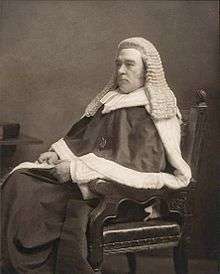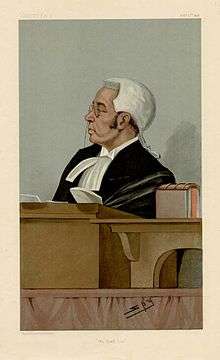John Bigham, 1st Viscount Mersey
| The Right Honourable The Viscount Mersey | |
|---|---|
 Lord Mersey | |
| Member of Parliament for Liverpool Exchange | |
|
In office 7 August 1895 – 10 November 1897 | |
| Preceded by | Ralph Neville |
| Succeeded by | Charles McArthur |
| Personal details | |
| Born |
3 August 1840 Liverpool |
| Died |
3 September 1929 (aged 89) Littlehampton, Sussex |
John Charles Bigham, 1st Viscount Mersey (3 August 1840 – 3 September 1929) was a British jurist and politician. After early success as a lawyer, and a less successful spell as a politician, he was appointed a judge, working in commercial law.
After his retirement, Mersey remained active in public affairs, and is probably best remembered for heading the official Board of Trade inquiries into the sinking of steamships, most notably the RMS Titanic, the RMS Lusitania, and the RMS Empress of Ireland.
Biography
Early years
Bigham was born in Liverpool, the second son of John Bigham, a prosperous merchant, and his wife Helen, née East.[1] He was educated at the Liverpool Institute High School for Boys, and the University of London, where he studied law.
Bigham left the university without taking a degree. He then travelled to Berlin and Paris to continue his education. Called to the bar in 1870 by the Middle Temple, he practised commercial law in and around his native city. On 17 August 1871 he married Georgina Sarah Rogers, also from Liverpool. The first of their three sons, Charles Clive Bigham (2nd Viscount Mersey), was born in 1872.[1]
Barrister and judge

In 1883, Bigham was named a Queen's Counsel.[1] His commercial practice prospered. In 1885, he tried his hand at politics, standing as a Liberal candidate for Parliament at the Liverpool constituency of East Toxteth, but lost.[2] In 1892, he stood unsuccessfully in another Liverpool seat, the Exchange constituency.[2] He was finally elected at his third attempt in 1895, standing as a Liberal Unionist.[2] He was never able to make a great political impact, and his interest in politics was less than his interest in his legal work, which continued to flourish.[1] During his last decade as a barrister, he was so in demand that he became one of the richest lawyers in his circle.[1]
In October 1897, Bigham was named a judge to the Queen's Bench,[3] continuing his work in business law, and disqualifying him being an MP.[2] He was knighted the following month.[4] He presided over the railway and canal commission of 1904, worked in the bankruptcy courts, and reviewed courts-martial sentences handed down during the Second Boer War. He was appointed President of the Probate, Divorce and Admiralty Division in 1909, but found the divorce work unfulfilling and retired in 1910.[1] He was raised to the peerage as Baron Mersey, of Toxteth in the County Palatine of Lancaster, in the same year.[1]
The Titanic
In 1912, Mersey received his greatest fame when he was appointed by Lord Loreburn, the Lord Chancellor in the government of Herbert Henry Asquith, to head the inquiry commission into the sinking of the RMS Titanic. There was some criticism of his handling of the inquiry; some felt he was biased towards the Board of Trade and the major shipping concerns and cared too little about finding out why the ship sank. (In 1998, the historian Daniel Butler described Mersey as "autocratic, impatient and not a little testy", but noted the "surprising objectivity" of the inquiry's findings.)[5]
In 1913, Mersey presided over the International Convention for the Safety of Life at Sea and added three more maritime inquiries to his résumé with his heading of the inquiries into the sinkings of the RMS Empress of Ireland (held in Canada in 1914) and the Falaba and RMS Lusitania in 1915. About the last, Mersey is among those suspected by conspiracy theorists of a coverup. His biographer Hugh Mooney writes that such suspicions are wholly conjectural, but "the conclusion of the inquiry (which blamed Germany for the tragedy without reservation) was without doubt politically convenient."[1] Mersey was raised in the peerage from baron to viscount in 1916.
Last years
In his later years, Mersey was beset by deafness, but continued to work actively, returning to the bench in his 80s when the divorce courts had a heavy backlog; Mooney writes, "he helped to clear the lists with all his old efficiency". His wife died in 1925, and he died four years later at Littlehampton in Sussex, aged 89.[1]
Mersey's third son (although the second surviving) was Sir Trevor Bigham, who became Deputy Commissioner of Police of the Metropolis. His first son, Colonel Charles Clive Bigham, survived the sinking of the passenger ship SS Persia in 1915.
Notes
- 1 2 3 4 5 6 7 8 9 Mooney, Hugh. "Bigham, John Charles, first Viscount Mersey (1840–1929)", Oxford Dictionary of National Biography, Oxford University Press, 2004; online edition, May 2006, accessed 28 April 2011 (subscription required)
- 1 2 3 4 Craig, F. W. S. (1983) [1989]. British parliamentary election results 1885–1918 (2nd ed.). Chichester: Parliamentary Research Services. pp. 139, 141. ISBN 0-900178-27-2.
- ↑ The London Gazette: no. 26902. p. 5799. 22 October 1897. Retrieved 5 September 1922.
- ↑ The London Gazette: no. 26915. p. 7172. 30 November 1897. Retrieved 6 September 1922.
- ↑ Butler, quoted in ODNB
References
- Butler, Daniel (1998). "Unsinkable": the full story of the RMS Titanic. Mechanicsburg, PA: Stackpole Books. ISBN 0-8117-1814-X.
- Leigh Rayment's Peerage Pages
- Leigh Rayment's Historical List of MPs
External links
| Wikimedia Commons has media related to John Bigham, 1st Viscount Mersey. |
- Works by or about John Bigham, 1st Viscount Mersey at Internet Archive
- Hansard 1803–2005: contributions in Parliament by the Viscount Mersey
- Portraits of John Bigham, 1st Viscount Mersey at the National Portrait Gallery, London

| Parliament of the United Kingdom | ||
|---|---|---|
| Preceded by Ralph Neville |
Member of Parliament for Liverpool Exchange 1895–1897 |
Succeeded by Charles McArthur |
| Peerage of the United Kingdom | ||
| New creation | Viscount Mersey 1916–1929 |
Succeeded by Charles Clive Bigham |
| Baron Mersey 1910–1929 | ||